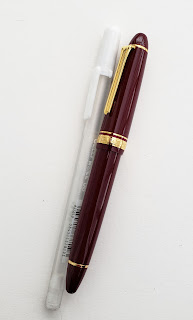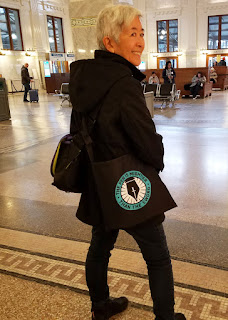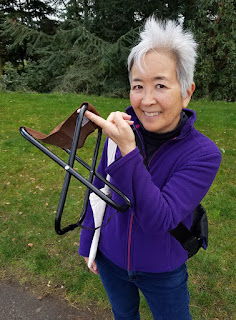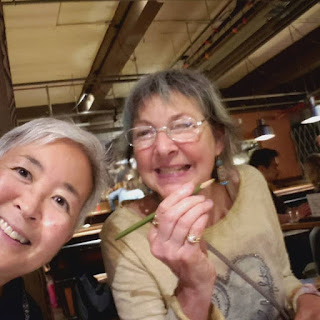 |
| Bag dump: My sketch kit contents for Amsterdam (and every day) |
As participants gear up for the 10th annual international
Urban Sketchers Symposium in Amsterdam, much of the social media discussion
is about what sketch materials and tools to bring, accessories to keep them
organized, and the bag to haul everything in (And let’s face it: Everyone likes
to talk about art materials!). I understand the anxiety; no one wants to be
caught short thousands of miles from home, where replacing or finding an
essential product might be challenging. This uncertainty would be present for
any kind of travel, but the symposium adds another level of challenge because
of the workshops. Instructors may have a long list of required or suggested
supplies that must be added to the usual at-home arsenal.
Amsterdam will be my sixth symposium since 2013, and with each I’ve
attended, I’ve learned more about my sketch material needs. In between those
travels, I’ve made numerous other domestic and international trips, and all
those travel experiences have helped me refine my sketch kit.
I think I can boil down everything I’ve learned to this one principle:
The best travel sketch kit is one that is no different from the one I use and
carry every day. There’s nothing to get used to or learn, like bag pockets
in unfamiliar places, or new materials and tools. If I don’t reach for a tool
during a walk around my neighborhood, then I’m unlikely to use it in Amsterdam.
Conversely, if I don’t need it 5,000 miles from home, maybe I don’t need it at
home, either.
Before writing this post, I reviewed the posts I wrote before all
the previous symposiums I attended and looked at the photos of the art
materials to see how they (and I) have changed. I did a lot of hemming and hawing
to prep for Barcelona, my very first symposium, and that’s to be
expected. At that point, I had been sketching for less than two years, and the
trip was also my first international travel since I had begun sketching.
Everything would be a new experience, and I didn’t know what to expect. I still
recall (fondly now) the high excitement as well as high anxiety about that
trip. My uncertainty shows in the amount of stuff I brought! After that
trip, I learned so much about travel sketching that I wrote a lengthy post summarizing my new knowledge.
For Brazil and the Paraty symposium the following year, I
heeded my own advice from Barcelona and refined my kit. But something happened
in 2016 as I prepped for the UK and the Manchester symposium. Maybe my responsibilities
as a correspondent that year made me feel like I had to be prepared for any possible
sketch material need (once again, my level of anxiety was directly proportional
to the amount of stuff I brought). Or maybe it was just that I was making a
transition from ink and watercolors to colored pencils and markers, so I had to
have everything. When I look now at the photo of my bag dump, my
shoulder twitches from the memory! According to the post, my travel haul was
very similar to my daily-carry. At least it shows that I was following the same
principle I follow today: The best travel kit is one that is the same as usual.
Now, as I prep and pack for Amsterdam, I’ve followed my basic principle
almost literally: The sketch kit that I’m bringing (top of post) is exactly the
same as what I carry every day (except for two items that I took out; see
below). Typically I prepare for travel by researching Internet images of the cities
I will be visiting to see if I’ll encounter any hard-to-mix or unique hues, and
I refresh my colored pencil palette accordingly. Amsterdam, as colorful as it
is, doesn’t seem to have any unique colors, so that step was easy: I’m using my
usual spring/summer palette:
 |
| My current colored pencil palette: Mostly Caran d'Ache Museum, a few Faber-Castell Albrecht Durer and one Caran d'Ache Neocolor II water-soluble crayon for sky washes. |
(Incidentally, for any European
trip, I make sure to bring verdigris (Caran d’Ache 182), which is so useful for
statuary and building details. I would normally take it out of my bag upon returning
home, but more recently I’ve discovered that a pale, minty green is difficult to
mix, so I’ve left it in my bag, and it has come in handy many times.)
 |
| Out: Gelly Roll and fountain pen |
The two things I took out of my bag? A white Gelly Roll gel pen
(which I use only with toned or red paper) and a fountain pen. The latter is a
big deal to me – its removal represents a full transition away from the ink
linework I had been using since almost Day 1. I’ve been moving in this direction
for a while, but I’ve been carrying a fountain pen all along, “just in case.” I
still love drawing with fountain pens, but I’m trying to avoid the fiddly
details that fountain pen nibs seem to invite. When I occasionally use linework
now, I tend to use a brush pen in that role. As I was examining my bag contents
last week, I realized I rarely use a fountain pen anymore, and this trip would
be a good opportunity to take it out entirely. (Maybe I’ll take care of my
fountain pen needs by devoting next InkTober to one.)
Here’s a closeup of the tools and other materials:
1. Tortillon
2. White Derwent Drawing Pencil. Like the Gelly Roll, I use
this only with toned or red paper, which I won’t be bringing on the trip. I
almost took it out, but what if I receive some new toned paper in my goody bag as I did in Chicago? There’s no substitute for a white colored pencil.
4. 8B graphite pencil
5. Blackwing graphite pencil with soft core (about 4B)
8. Kneadable eraser (kept in a slender, hinged Daniel Smith
watercolor crayon box)
9. Two black brush pens – one waterproof, one water-soluble.
I use many different brands with no specific favorites as long as one is waterproof
and one is water-soluble. Shown here are a waterproof Tombow Fudenosuke and
a water-soluble Kuretake Fudegokochi.
If you’re wondering which materials are specifically for workshops, the answer
is none! Both workshops I signed up for are related to composition, not
materials, so the supplies suggested by the instructors were only the students’
usual favorites.
The sketchbooks I’m bringing represent the largest deviation from
my at-home daily-carry:
1. Instead of the softcover Stillman & Birn Zeta sketchbook
that I’ve been using the past several months (and for the most part have been enjoying),
I bought a 12-by-9-inch spiralbound Zeta sketchbook and removed the spiral binding.
After trimming off the binding holes, I folded and stitched the paper into six
signatures (four sheets/eight pages each). These will enable me to carry a thin,
lightweight signature instead of a bound book while traveling. When I get home,
I’ll bind them together with Coptic stitch.
3. The pocket-size Rhodia notebook will serve as both my travel
journal and my receptacle for quick sketches on the run. I used Rhodia
notebooks for several trips before switching to a Field Notes Signature last
year for Portugal. While I enjoyed the slightly larger format of the Signature,
it contains only 72 pages, and I filled it before the trip was over. I’m going back
to the Rhodia, which has 96 pages (and the hardbound covers are more durable).
 |
| The Rickshaw Musette tote bag |
4. The Strathmore watercolor postcard pad is one I carry
routinely in my suitcase when I travel with every good intention of using (but
you know what they say about where good intentions lead). The problem is that
it stays in my suitcase instead of coming with me in my bag – so it rarely gets
used (though I did use a few in Porto). I would like to get into the habit of
making and mailing at least a few sketch postcards whenever I travel. This time
I’ll keep it in the Rickshaw Musette tote bag that will supplement my
daily-carry bag.
 |
| My trusty everyday-carry since 2012. |
 |
| Everything in its place. |
Finally, two other items will be carried in the tote bag when I’m
not using them: my new Costco sunhat (festooned with symposium buttons) and my tiny Daiso folding stool. Although most of the time I prefer to stand while
sketching, it’s nice to have a seat during workshops and when I’m doing a leisurely
graphite sketch that could take a while.
OK – I’m ready to go (well, except for nonessentials like clothes)!
 |
| Hoping for sunshine! |
 |
Yes, I fit on it -- barely. I'll have to be wary of
my consumption of stroopwafel. |


















































